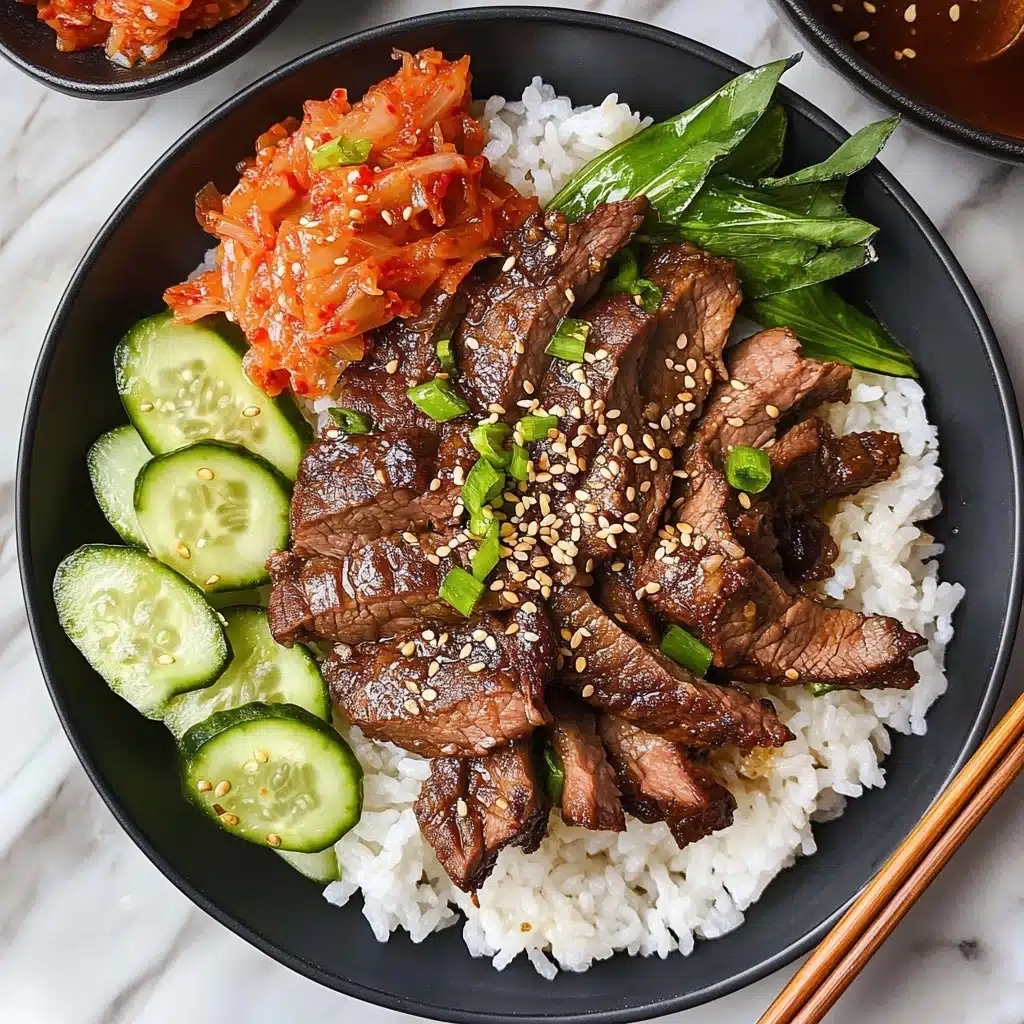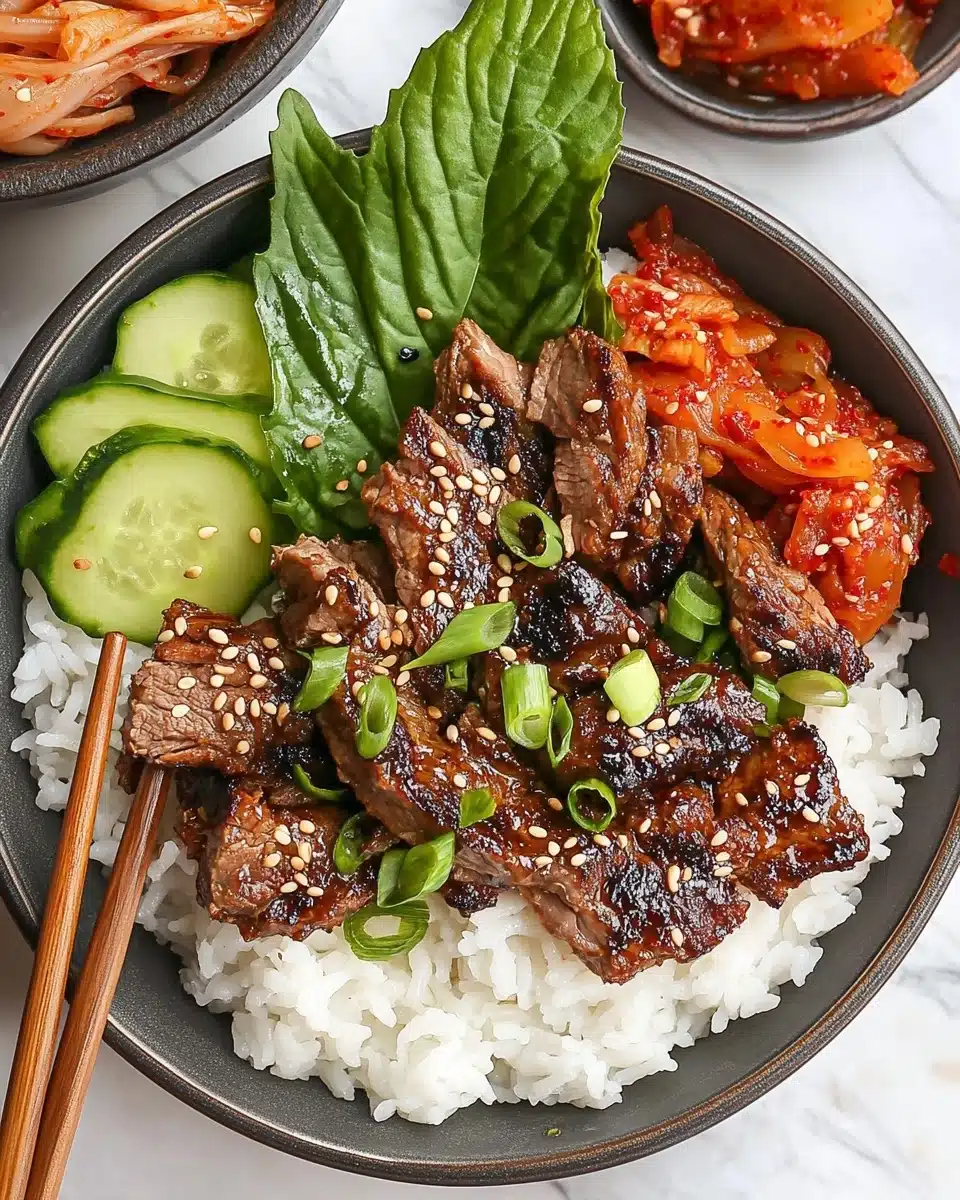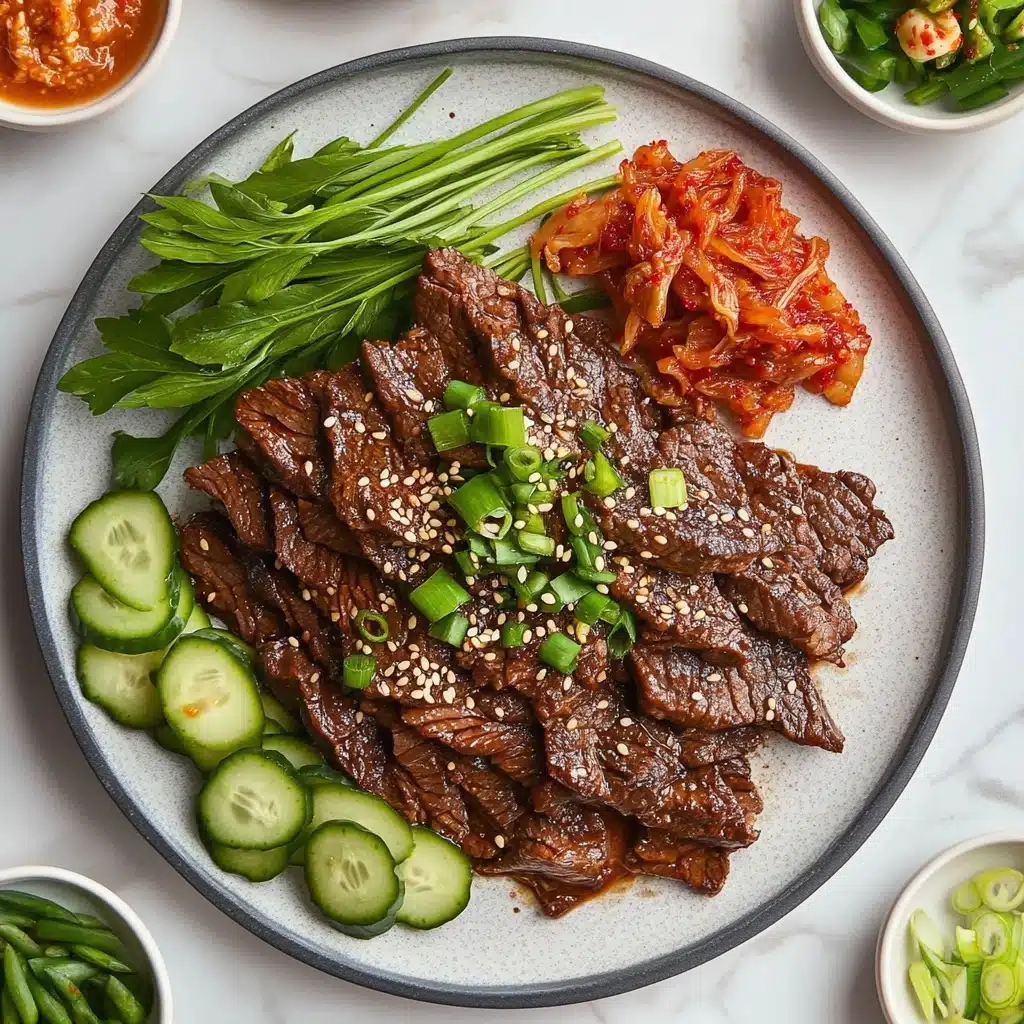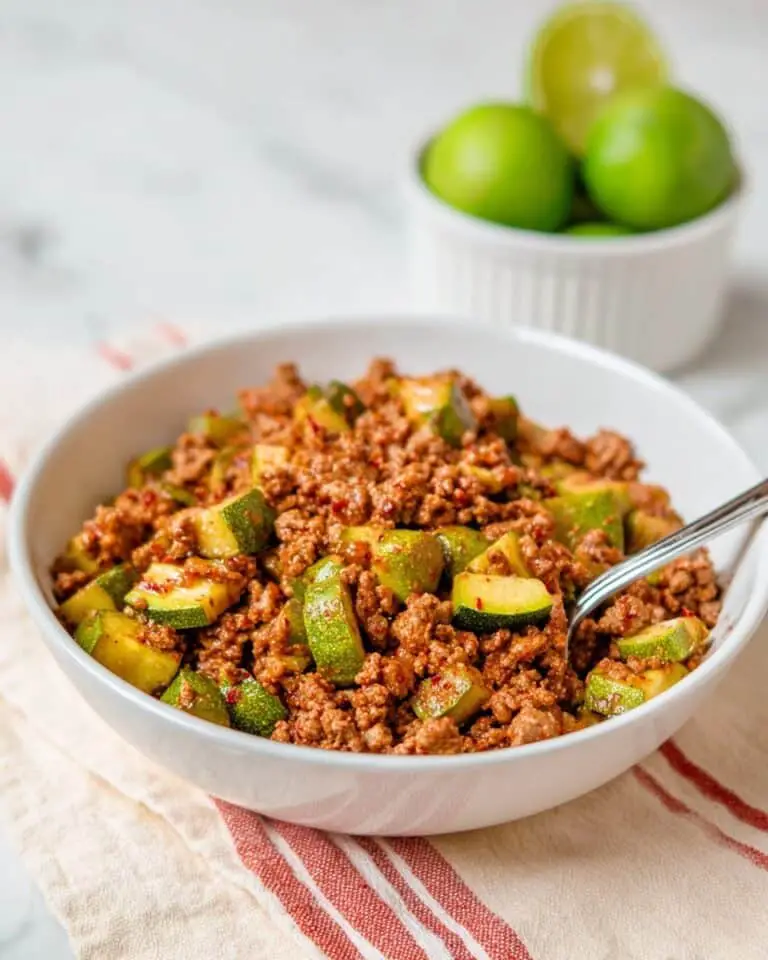Are you ready to spice up your dinner table with a taste of Korean magic? Enter the flavorful world of Korean Beef Bulgogi, a dish that will tantalize your taste buds with its sweet, savory, and slightly spicy notes. It’s a personal favorite for anyone looking to infuse a bit of excitement into their meal routines.
Why You’ll Love This Recipe
- Authentic Flavor: This dish captures the essence of Korean cuisine with its blend of sweet, spicy, and savory flavors.
- Quick Cooking: Despite its deep flavors, this recipe cooks up in minutes, perfect for busy weeknights.
- Customizable: Easily adaptable to your taste preferences or dietary needs.
Ingredients You’ll Need
The beauty of Korean Beef Bulgogi is its blend of straightforward ingredients that work together like magic. Each one plays a crucial role in enhancing the overall taste, texture, and color of this delightful dish.
- Boneless rib eye steak: Freezing it slightly makes slicing easier and ensures every piece absorbs the marinade.
- Pear: This adds a unique sweetness and tenderizes the beef naturally.
- Reduced sodium soy sauce: Helps balance flavors while keeping your sodium levels in check.
- Brown sugar: Enhances the caramelization during cooking, giving that rich bulgogi finish.
- Toasted sesame oil: Imparts a distinct nutty aroma that is quintessential to Korean cuisine.
- Gochujang: Offers a gentle kick of heat with a deep, fermented complexity.
- Vegetable oil: Used for grilling, ensuring a crispy texture on the outside.
- Green onions and sesame seeds: These add a fresh, aromatic finish that rounds off the dish beautifully.
Variations
Don’t be afraid to make this Korean Beef Bulgogi your own! Feel free to experiment with variations that cater to your tastes or dietary preferences.
- Vegetarian Option: Replace beef with tofu or mushrooms to create a plant-based version that’s just as flavorful.
- Extra Spicy: Add more gochujang or a sliced fresh chili to increase the heat.
- Low-Carb: Serve over cauliflower rice instead of traditional white rice for a lighter option.
How to Make Korean Beef Bulgogi
Step 1: Prepare the Steak
Wrap your steak in plastic and freeze it for 30 minutes to firm it up. This simple trick makes it easier to slice thinly across the grain, ensuring that each piece absorbs the marinade and cooks quickly and uniformly.
Step 2: Marinate for Flavor
Combine your grated pear, soy sauce, brown sugar, sesame oil, garlic, ginger, and gochujang in a bowl. Toss in your sliced steak, ensuring each piece is well-coated in this flavorful marinade. Seal it in a bag, and let it rest in the fridge for at least two hours, or overnight for the most robust flavors.
Step 3: Grill to Perfection
Heat a tablespoon of vegetable oil in your trusty cast iron grill pan over medium-high heat. Cook the marinated beef slices in batches, about 2-3 minutes per side. This quick searing locks in flavors while developing beautiful grill marks.
Pro Tips for Making Korean Beef Bulgogi
- Chill Time: A brief stint in the freezer makes slicing the beef much simpler and more uniform.
- Marinate Longer: Letting the beef marinate overnight allows the flavors to deepen, making it extra delicious.
- High Heat Sizzle: Ensures a quick, charred crust while keeping the inside juicy and tender.
- Keep it Fresh: Garnish just before serving for the best texture and flavor presentation.
How to Serve Korean Beef Bulgogi

Garnishes
Top your Korean Beef Bulgogi with freshly sliced green onions and a sprinkle of toasted sesame seeds. These elements add a delightful crunch and burst of freshness to each bite.
Side Dishes
Pair your Bulgogi with a bowl of fluffy steamed rice, some spicy kimchi, and perhaps a side of stir-fried veggies. These sides balance the meaty richness perfectly.
Creative Ways to Present
Try serving the bulgogi in lettuce cups for a fresh and healthy twist, or roll it up in a wrap with a mix of julienned vegetables for a modern, on-the-go meal.
Make Ahead and Storage
Storing Leftovers
Place any leftover Korean Beef Bulgogi in an airtight container and store in the refrigerator. Consume within 3 days for optimal flavor and safety.
Freezing
If you want to freeze your Bulgogi, seal it in a freezer-safe bag without the garnishes. It can last for up to 2 months. Thaw overnight in the fridge before reheating.
Reheating
Warm your bulgogi gently over medium heat in a skillet, adding a splash of water or broth to keep it moist. Stir occasionally until heated through.
FAQs
-
Can I use a different cut of beef for Korean Beef Bulgogi?
Yes, you can! Thinly sliced flank or sirloin steak also works well if rib eye isn’t available.
-
Is Korean Beef Bulgogi spicy?
The dish has a mild spiciness from the gochujang, but you can adjust the heat level by adding more or less to taste.
-
What if I don’t have gochujang?
In a pinch, you can use a mixture of miso paste and sriracha as a substitute, though the flavors will slightly differ.
-
How can I make this dish gluten-free?
Simply swap the soy sauce for a gluten-free alternative like tamari or coconut aminos and you’re good to go!
Final Thoughts
If there’s one dish that can transport you straight to a vibrant Korean street market, it’s this Korean Beef Bulgogi. I can’t recommend it enough if you’re looking to indulge in something as delicious as it is easy to prepare. So give it a try, and don’t be surprised if it becomes a new staple in your culinary repertoire!
Print
Korean Beef Bulgogi Recipe
- Prep Time: 2 hours 45 minutes
- Cook Time: 15 minutes
- Total Time: 3 hours
- Yield: 6 servings
- Category: Main Course
- Method: Frying
- Cuisine: Korean
Description
Korean Beef Bulgogi is a flavorful and tender marinated beef dish featuring thinly sliced rib eye steak, marinated in a savory mixture of pear, soy sauce, sesame oil, garlic, ginger, and gochujang. It is cooked quickly on a cast iron grill pan until charred and caramelized, then garnished with green onions and sesame seeds for a deliciously authentic Korean flavor. Perfect for a quick weeknight meal or special occasion.
Ingredients
Meat and Marinade
- 1 1/2 pounds boneless rib eye steak
- 1/2 small pear, peeled and coarsely grated
- 1/4 cup reduced sodium soy sauce
- 2 tablespoons brown sugar
- 2 tablespoons toasted sesame oil
- 3 cloves garlic, minced
- 1 tablespoon freshly grated ginger
- 1 tablespoon gochujang, Korean red pepper paste
Cooking and Garnish
- 2 tablespoons vegetable oil, divided
- 2 green onions, thinly sliced
- 1 teaspoon toasted sesame seeds
Instructions
- Chill and Slice Steak: Wrap the steak tightly in plastic wrap and freeze for 30 minutes to make slicing easier. Unwrap the steak and slice across the grain into ¼-inch thick slices.
- Prepare Marinade: In a medium bowl, combine the grated pear, soy sauce, brown sugar, toasted sesame oil, minced garlic, grated ginger, and gochujang. Mix well to create a uniform marinade.
- Marinate Beef: Place the sliced steak and marinade in a large Ziploc bag, seal it, and toss to coat. Refrigerate and marinate for at least 2 hours, preferably overnight, turning occasionally for even flavor absorption.
- Cook Steak: Heat 1 tablespoon of vegetable oil in a cast iron grill pan over medium-high heat. Working in batches, add slices of beef in a single layer and cook for 2-3 minutes per side until charred and cooked through. Add more oil as needed between batches.
- Serve: Immediately transfer cooked beef to a serving platter. Garnish with sliced green onions and toasted sesame seeds. Serve hot with steamed rice or vegetables.
Notes
- If you don’t have a cast iron grill pan, a large cast iron skillet can be used instead.
- For extra flavor, you can brush the beef with a little additional sesame oil after cooking.
- Adjust the amount of gochujang for desired spice level.
- Ensure the steak slices are uniform for even quick cooking.
- Marinating overnight enhances flavor but a 2-hour marinade is sufficient for good taste.
Nutrition
- Serving Size: 1/6th of total recipe
- Calories: 340 kcal
- Sugar: 8 g
- Sodium: 620 mg
- Fat: 23 g
- Saturated Fat: 4 g
- Unsaturated Fat: 19 g
- Trans Fat: 0 g
- Carbohydrates: 14 g
- Fiber: 1 g
- Protein: 27 g
- Cholesterol: 70 mg









